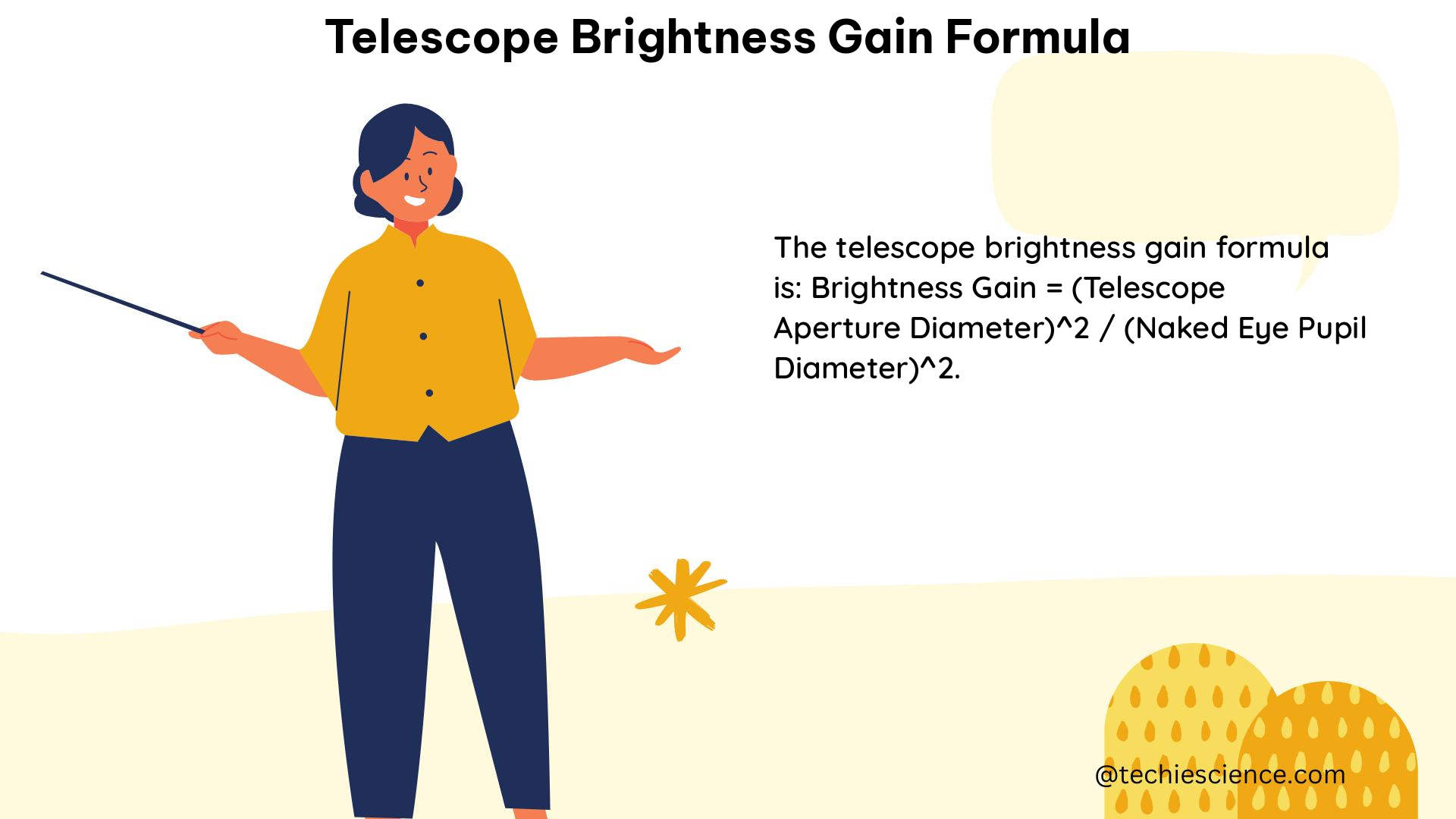The telescope brightness gain formula is a fundamental concept in radio astronomy, providing a way to quantify the strength of radiation and its variation with direction, frequency, and distance. This formula is crucial for understanding the behavior of electromagnetic radiation and its interaction with astronomical objects.
Understanding the Brightness Gain Formula
The brightness gain formula is directly proportional to the antenna temperature in the Rayleigh–Jeans low-frequency approximation. This relationship can be expressed mathematically as:
Brightness Gain = k * Antenna Temperature
where k is a constant that depends on the specific characteristics of the telescope and the observational setup.
The brightness temperature is a convenient way to specify power per unit solid angle per unit bandwidth in terms of the Rayleigh–Jeans approximation. It is often used in radio astronomy because radio telescopes are often calibrated by absorbers or “loads” of known temperature, and because the temperature of a radio source is frequently a quantity of physical interest.
However, it is essential to note that brightness temperature is not the same as physical temperature. Nonthermal sources, such as synchrotron radiation, have frequency-dependent brightness temperatures but do not have well-defined physical temperatures. Thermal sources, on the other hand, have brightness temperatures lower than their physical temperatures if they are semitransparent or partially reflecting.
The Radiative Transfer Equation and Kirchhoff’s Law

The radiative transfer equation (2.27) is used to understand and interpret observations of radiation. This equation describes the change in the specific intensity of radiation as it propagates through a medium. Kirchhoff’s law can be used to eliminate the unknown because the atmosphere is in local thermodynamic equilibrium (LTE).
The brightness or intensity of the Sun’s radiation does not depend on distance, but the apparent flux does. The number of photons per unit area hitting the detector is proportional to cos(θ), where θ is the angle between the normal to the detector and the direction of the incoming rays. Likewise, at the source, such as the spherical Sun, the projected area perpendicular to the line of sight is proportional to cos(θ), where θ is the angle between the line of sight and the normal to the Sun’s surface.
Specific Intensity and Brightness
The total brightness is contributed by photons of all frequencies. The brightness per unit frequency is called the specific intensity (also spectral intensity or spectral brightness). The notation for specific intensity is I_ν, where the subscript ν is used to indicate “per unit frequency”.
The specific intensity is a crucial quantity in radiative transfer theory, as it describes the energy flux per unit solid angle per unit frequency. It is often used to characterize the brightness of astronomical sources, such as stars, galaxies, and nebulae.
Practical Applications and Examples
The telescope brightness gain formula has numerous practical applications in radio astronomy and other fields of physics. For example, it can be used to:
-
Calibrate Radio Telescopes: The brightness gain formula is used to calibrate radio telescopes by relating the observed signal to the brightness temperature of the observed source.
-
Analyze Nonthermal Radiation: The frequency-dependent nature of brightness temperature in nonthermal sources, such as synchrotron radiation, can be used to study the physical properties of these sources, such as the energy distribution of the emitting particles.
-
Measure Atmospheric Properties: The radiative transfer equation and Kirchhoff’s law can be used to measure the properties of the Earth’s atmosphere, such as temperature and composition, by observing the absorption and emission of radiation.
-
Study Stellar and Galactic Evolution: The brightness gain formula and related concepts can be used to study the evolution of stars and galaxies by analyzing the observed radiation from these objects.
Here’s an example of how the telescope brightness gain formula can be applied:
Suppose a radio telescope is observing a distant galaxy. The observed specific intensity at a frequency of 1.4 GHz is I_ν = 1.2 × 10^-20 W/m^2/Hz/sr. The antenna temperature of the telescope is measured to be T_a = 50 K. Using the brightness gain formula, we can calculate the brightness gain of the telescope as:
Brightness Gain = k * T_a
Brightness Gain = k * 50 K
where k is the constant of proportionality between the brightness gain and the antenna temperature.
By rearranging the formula, we can solve for k:
k = Brightness Gain / T_a
k = (I_ν) / T_a
k = (1.2 × 10^-20 W/m^2/Hz/sr) / (50 K)
k = 2.4 × 10^-22 W/m^2/Hz/sr/K
This value of k can then be used to calculate the brightness gain of the telescope for other observations or to calibrate the instrument.
Conclusion
The telescope brightness gain formula is a fundamental concept in radio astronomy and other fields of physics. It provides a way to quantify the strength of radiation and its variation with direction, frequency, and distance. By understanding the underlying principles and practical applications of this formula, physics students can gain a deeper appreciation for the behavior of electromagnetic radiation and its interaction with astronomical objects.
References
- Radiation Fundamentals, National Radio Astronomy Observatory, https://www.cv.nrao.edu/~sransom/web/Ch2.html
- Determining the best-fitting slope and its uncertainty for up-the-ramp near-infrared detectors, Roman Telescope Branch, https://www.stsci.edu/files/live/sites/www/files/home/roman/_documents/Roman-STScI-000394_DeterminingTheBestFittingSlope.pdf
- What can we learn from light curves?, RIT, http://spiff.rit.edu/classes/phys373/lectures/light_curves/light_curves.html

The lambdageeks.com Core SME Team is a group of experienced subject matter experts from diverse scientific and technical fields including Physics, Chemistry, Technology,Electronics & Electrical Engineering, Automotive, Mechanical Engineering. Our team collaborates to create high-quality, well-researched articles on a wide range of science and technology topics for the lambdageeks.com website.
All Our Senior SME are having more than 7 Years of experience in the respective fields . They are either Working Industry Professionals or assocaited With different Universities. Refer Our Authors Page to get to know About our Core SMEs.